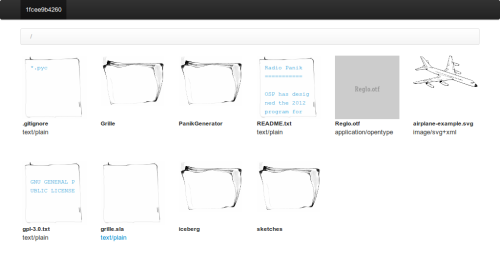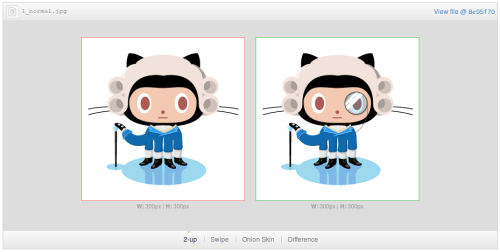One of the hot topics at the Lbire Graphics Research Unit Co-Position meeting came from the Visual Versioning work session. The work session focused on creating mockups for ways to improve their Visual Culture Git Viewer.

This tool goes some way to addressing the issue of not being able to visualise the contents of a repository by providing thumbnails of the contents. One of the functions missing from this tool is the ability to compare and merge different versions images. Github already provides the ability to compare still images (.jpg .png etc) in various different ways:

However, this is only a way to compare the output of the program. How could revision tools work with PSD/XCF, SVG or SLA files that contain more information such as layers and tools used to complete tasks?
Non-Liner Version Control in GIMP
A team of researchers has attempted to address this problem, at least in GIMP. Their work demonstrates an extremely effective way of doing version control from within GIMP
The research surrounding this tool is available to view and hopefully it’ll one day be implemented into GIMP. Whilst this solution is very effective and address every problem mentioned so far, it creates another problem: It is tied to GIMP and is not easily transferable to other programs. Trying to apply this to other programs such as Scribus or Inkscape would require extra resources, which are in scarce supply. Essentially what is needed is a program-neutral solution that would require few additionaly resources to implement.
Ctrl+Z
Almost all modern programs allow you to undo your actions. When you look at this with more detail you begin to see that undo is a (highly unsafe) method of revision control. By using Ctrl + Z and Ctrl+Y/Ctrl+Shift+Z you can scroll through previous states of a file. All of the data surrounding your use of the program, such as what tools you have used, what files you have opened and possibly even the time each action was executed, are being recorded in the undo history. One solution proposed in the work session was to devise a way to capture and record this data. By doing so you could “play back” the file through each of its stages. Once you have this data you could then begin to build a standalone tool that operates in a similar way to the GIMP revision control tool
Edit Decision List
A very common way in which people implement their own version control system is to create numbered revisions of their files. For plain text files this presents few problems, but for binary files (PSD/XCF etc) it could mean that you have many large files which present a whole host of problems around bandwidth and storage space. Ana Carvalho and Ricardo Lafuente, who produce Libre Graphics Magazine with ginger coons, revealed that the repository for the magazine – including previous issues – has reached 8GB.
The solution proposed at the work session would address this issue as you would only need one copy of the original files that you work from. The “undo data” would be captured to a separate file that would then simply apply those actions to the file.
GEGL
GEGL, which is the new core powering future versions of GIMP is, to my knowledge, already working in a non-destructive way. Peter Sikking, the lead interaction and UI designer for GIMP, has more to say on this topic.

Users of Blender and other node-based compositors will already be familiar with this approach. Effects are chained together in a non-destructive and then sent to an output file. As Pete Sikking describes:
If the structure of [the] graph is written to a file—apart from the input images, all other boxes are just snippets of XML—and a year later it is re‑opened in GIMP, then each of the operations and their parameters; each of the vector shapes or text can be freely changed
If the time can also be recorded then you could essentially reconstruct an image using nothing but the input files and this XML file.
Next steps
Of course, at the moment, all of this is theory and ideas which, in some ways, was the purpose of the work session. For this to be taken further what needs to be done is to first find a way to expose the data that is saved in the undo states. If this data is useful then the next steps can begin. Then, if it looks like a viable solution, all that is needed is developers willing to take on the task.
Thanks…
My thanks go to Constant and its many partners for organising for Libre Graphics Research Unit and to those in the work session – Ana Carvalho, Eric Schrijver, Ale Rimoldi, Gijs de Heij, Thomas Laureyssens and Camille Bissuel – whose ideas this blog post contains, along with some of my own.